

Boatcaft Plans and Kits
Boatcraft offers a range of kits and plans, ranging from small boats, to cruisers, to catamarans.
Please contact us directly when wishing to order plans or kits
The distinctive design of the Queensland Moreton Bay cruisers and the Halvorsen cruisers from NSW has been incorporated into this motor launch commissioned from our Sydney based naval architect David Payne. With many appropriate semi-protected waterways around Australia, this is an ideal boat for the leisurely weekend and holiday cruising.
Boatcraft Pacific 8M Trailerable Motor Launch
Boatcraft Pacific 10M Motor Launch
Bliss-craft Oceaneer MK II
The result has been a boat featuring a high bow to ride over the waves rather than punch through them, a fine deep Vee entry to soften the ride, and a good straight run aft for optimum planning performance. The high bow with its good reserve buoyancy also prevents nosedives in the following sea. The Oceaneer has a fully self-draining cockpit floor, supported by buoyancy foam as an important additional safety feature, making the boat unsinkable.
Boatcraft Cats
It has all the features of much larger boats, cleverly designed into a compact economical craft.. The boat is also available as a comfortable live-aboard power cat. It will have particular appeal to both private owners, and to hire fleet operators seeking a small economical easily handled boat. The vessel, from multi-hull designer Ashley Holliday, is based on the highly efficient Thruster hull form. These narrow, low resistance hulls are very easily driven, and with their long waterline, they provide exceptional stability and performance.
9.5m Boatcraft Performance Catamaran Plans
12m Boatcraft Performance Catamaran
Simpson Cats
6.5M Woodwind Catamaran
7.3m Breton Strip Plank Bridgedeck Catamaran
8.2 m Backslash Catamaran
8.3m Catamaran
9M Groundeffect Catamaran Plans
9m Sine Wave Catamaran
9.1 m Woodwind Catamaran
10.2m Catamaran
10m Wildside Catamaran
10.3m Woodwind Catamaran
11 Metre Catamaran
11.88m Catamaran
12m Simpson Catamaran
12.01m Simpson Catamaran
12.2m Woodwind Catamaran
Michael Storer Plans and Kits
Quick Canoe by Michael Storer - Plans & Instruction Book
Eureka 155 Touring Canoe by Michael Storer, Plan or Kit
Handy Punt by Michael Storer Plans & Instruction Book
Goat Island Skiff by Michael Storer Plans & Instruction Book
Ian Oughtred Plans and Kits
The wooden boat revival has been a long time coming, but now it has arrived, there is one name that stands out above all others: Iain Oughtred. A former dinghy racer turned boatbuilder and designer, Iain developed a cult following both for the beauty of his designs and the quality of the drawings. Challenging the view that building boats were the province of the wealthy, he created exceptionally appealing yet inexpensive wooden boats ideal for amateur construction, often basing the designs on traditional local craft. Still going strong, his designs now number more than 100 and are built around the world by amateurs and professionals alike.
Iain Oughtred. A Life In Wooden Boats. Book.
Clinker Plywood Boatbuilding Manual. Iain Oughtred.
Lapstrake Plywood Boat Design Catalogue- Iain Oughtred
Tammie Norrie by Iain Oughtred; 13' 6" Clinker Dinghy.
Puffin by Iain Oughtred; 10' 2" Clinker Dinghy.
Humble Bee by Iain Oughtred 7' 9" Clinker Pram Dinghy

Sydney Wooden Boat School

The Snapper Boat 17″ (5.2m)
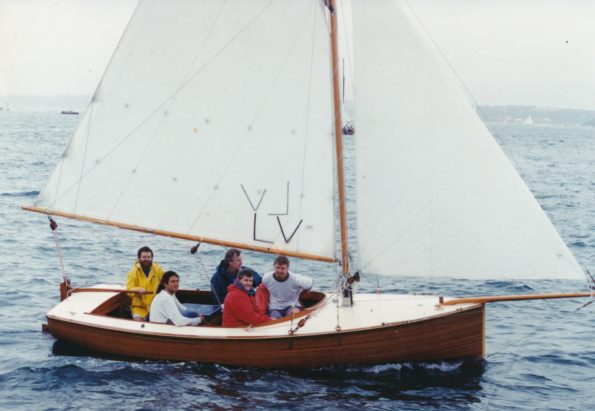
A number of other people admired the design as a motor boat without sailing rig, and a number of these have been built with larger motors than the sailing version. Some of the sailing versions have been built with an outboard under the aft deck working through a well built into the hull.
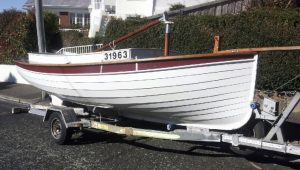
A Snapper Boat built with Ply Clinker planking
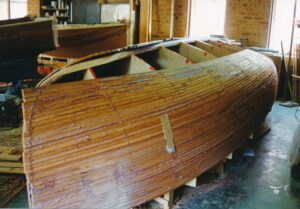
An easy boat to strip-plank.
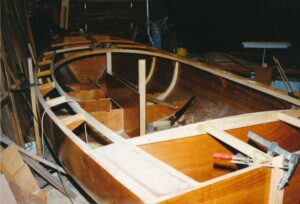
Internal structure and deck framing going into a strip-planked Snapper Boat.
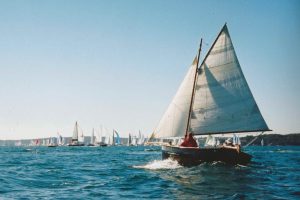
A great family sailer!
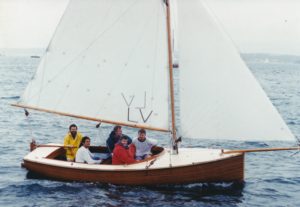
The Snapper Boat 17′ (5.2m)
Leave a reply cancel reply.
Your email address will not be published. Required fields are marked *
Save my name, email, and website in this browser for the next time I comment.
This site uses Akismet to reduce spam. Learn how your comment data is processed .
Popular searches
Popular pages.
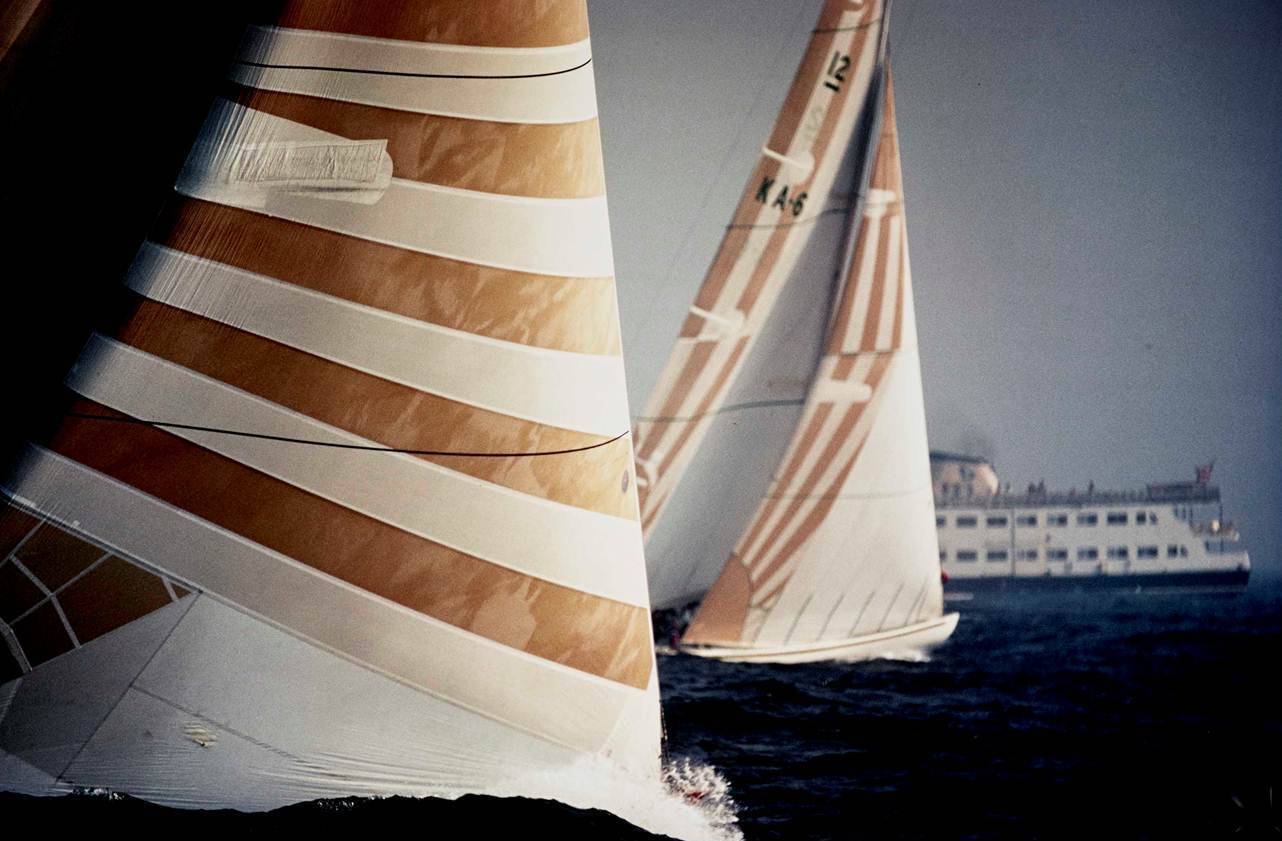
The race of the century – America’s Cup 1983
The action for final race for the America’s Cup in 1983, dubbed ‘the race of the century’ by US skipper Dennis Conner, began well before the race started. Mindful of some starting issues, the Australians called for a lay day after race six to put some practice in.
The action for final race for the America’s Cup in 1983, dubbed ‘the race of the century’ by US skipper Dennis Conner, began well before the race started. Mindful of some starting issues, the Australians called for a lay day after race six to put some practice in. Meanwhile, the US team used this to optimise their yacht Liberty with ballast and sail area changes to make it faster in the expected lighter winds, something the Australians had wished they had thought of too. Racing was abandoned for 24 September due to poor wind, and then the US team called a lay day themselves to do more work on Liberty , further irritating the Australians.

Australia II (KA 6) nicely out in front of Liberty in an earlier race, Sally Samins photographer.
When the gun finally fired on 26 September, two edgy teams, fully aware of the intense interest and outcome, got away to a tame start with Australia II in the slightly better position. Whilst it is always the aim to have the best sails, best design and best crew for maximum boat speed, yacht racing is also about tactical manoeuvres and reading the wind on the course. Choosing when to change direction, called ‘tacking’ upwind or ‘gybing’ downwind under spinnaker, can make significant gains or losses regardless of how good the yacht is.
As the two boats began tacking up the course, Australia II realised they faced a much faster Liberty and had lost some advantage they had previously held in these light shifty conditions. Shifty was a key word – the breeze had small, but important variations in direction and strength, and Liberty was first to gain, edging out ahead by just a couple of boat lengths when it benefitted from a better patch of breeze part way up the leg. They rounded the first mark with this small advantage, kept it on the first reach, and then lost ground on the next leg as Australia II nearly caught up again, showing it could do well under spinnaker on a square run – in hindsight this was a warning of things to come. They were still in the race and niggled away up the next windward leg, but just as Australia II closed on Liberty, another shift in direction and strength went Liberty’s way and they pulled out to almost a minute lead, turning into the next square run.
This was where everything Australia II had done came to the fore. Sensing the breeze was stronger on the left they followed Liberty toward that side, but straight away they could see they were sailing better. The hours of spinnaker testing and crew work had put them ‘in the groove’ and they immediately began to close the gap. Liberty ’s crew got edgy and started to look back at Australia II , loosing concentration which further slowed their yacht. Liberty then gybed to try and cover Australia II , who held their nerve and stayed with the better breeze while Liberty sailed into a lighter patch. Things were now going Australia II ’s way.
All the way down the course Australia II ’s crew held their composure, sailing their boat and not the looking to the other one, except for the tactician. When they did gybe they chose the right moments to take advantage of the small wind changes, while Liberty was losing more ground with additional gybes at the wrong moment, trying the keep in touch with Australia II as it gained on them. Australia II was dictating the tactics now from behind, and eventually they drew parallel, but going both faster and lower, meaning they were covering less ground toward the next mark.
As they closed on the last rounding mark at the bottom of the course, with both boats on opposing gybes the moment came when Australia II passed ahead of Liberty , still sailing faster and in phase with the small wind shifts. Choosing the right timing Australia II gybed down and then back again to the mark, rounding 21 seconds ahead of a horrified US team on Liberty .

The crucial moment, captured on a postcard, where Australia II passes ahead of Liberty on the run to the mark. ANMM collection
Liberty ’s crew did not give up for the final windward leg, knowing they had speed to match Australia II upwind and could still regain the lead through a tacking duel. Australia II put a tight cover over Liberty , then went back to a loose cover as they realised they were losing speed in the tacking manoeuvres. Liberty gained, but could not get even and neither team made any mistakes with their crew work despite making well over 40 tacks. Approaching the finish Conner tried one last trick, taking the yachts out to one side, beyond the shortest course to the finish, trying to gain time and maybe a wind shift that would close the gap. In the end it was Australia II that got a slight advantage when they tacked back toward the finish line, still holding a slim lead. Australia II benefitted from a stronger gust and pulled away from Liberty , crossing 41 seconds ahead, and into a permanent place in sporting history.

The gun goes and 132 years of US victory in the America’s Cup is ended by Australia II . ANMM Collection
Share this:
- Click to share on Facebook (Opens in new window)
- Click to share on Twitter (Opens in new window)
- Click to print (Opens in new window)
- Click to email this to a friend (Opens in new window)
- Click to share on Pinterest (Opens in new window)
- Click to share on Tumblr (Opens in new window)
- Click to share on LinkedIn (Opens in new window)
- Click to share on Reddit (Opens in new window)

David Payne
David Payne is Curator of Historic Vessels at Australian National Maritime Museum, and through the Australian Register of Historic Vessels he works closely with heritage boat owners throughout Australia researching and advising on their craft and their social connections. David has also been a yacht designer and documented many of the museum’s vessels with extensive drawings. He has had a wide sailing experience, from Lasers and 12-foot skiffs through to long ocean passages. Since 2012 he has been able to work closely with Aboriginal communities on a number of Indigenous canoe building and watercraft projects.

About Chuck Paine Yacht Design
The history of chuck paine’s yacht designs.

Onora, a 63-ft. aluminum voyager built by Kelly Archer in New Zealand.
Chuck Paine began designing sailing yachts professionally in 1971 as an apprentice to Dick Carter of Boston, and set up his own design company in 1974. C. W. Paine Yacht Design, Inc. operated from then until 2008, launching well over 1000 yachts with a combined value exceeding US$ 350,000,000. From the beginning his firm specialized in the high quality, high-priced end of the trade, designing both sail and powerboats, though it is probably best known for its offshore oriented cruising yachts.

Beginning in 2009, Chuck has founded a new and smaller company, Chuckpaine.com LLC , which today focuses upon the design and construction of small but extremely elegant daysailors and yacht club racing fleets for those who wish to simplify their leisure lives in style. Lessons derived from his lifetime of designing yachts can be studied by reading his two popular books on the subject: MY YACHT DESIGNS and the lessons they taught me – available as a digital book, and THE BOATS I’VE LOVED- 20 classic sailboat designs – available in both a digital and print version.
Morris Yachts
Morris Yachts of Maine have to date built 199 of the world’s highest quality yachts to Paine designs. These yachts were all individually customized for their owners, unusually well constructed, expensive, and worth every penny.
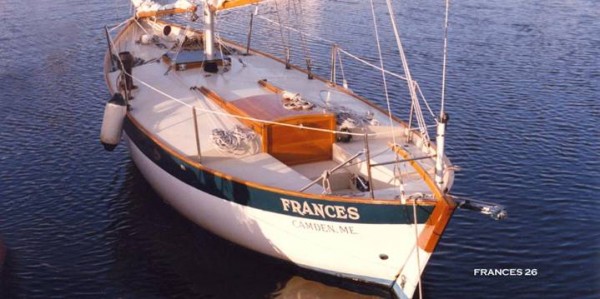
Small beginnings: Chuck Paine’s 26-ft. “Frances,” designed in 1973. Tom Morris began building them in 1974 and came back to Paine for 14 more designs.
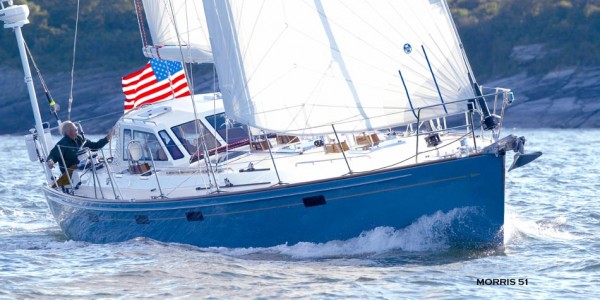
The Morris Apogee 51 is one of Morris’ high-speed cruising yachts.
The British Connection
The Paine office was the designer of eight of Britain’s most popular offshore-oriented designs, from which over 500 yachts were built by two Southampton area yards. These were the British FRANCES 26, the VICTORIA 30, 34 and 38, and the BOWMAN 40, 42, 45 and 48.
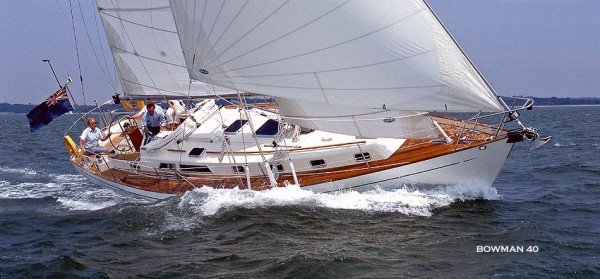
The Bowman 40

The Victoria 38
The Paine Keel
Chuck Paine invented the Paine Keel in 1981. It combines a very low center of gravity with minimal propensity to sideslip. Most Paine designs after this date were fitted with the Paine Keel. It has been widely copied by other designers.

The Bermuda Series
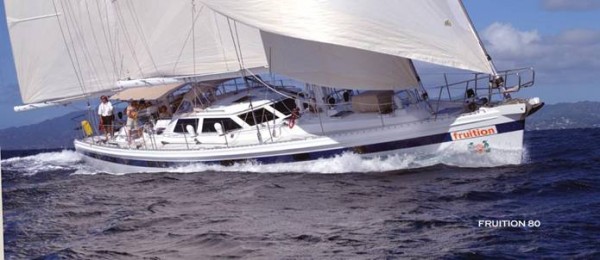
The Bermuda Series yachts were fast passagemakers. They were Chuck’s interpretation of Steve Dashew’s Deerfoot and Sundeer series, but built to a higher level of finish and fitted with the Paine Keel. Fruition is an 80-foot example built in aluminum at Kanter Yachts in Ontario.
Chuck’s “Bermuda Series” were intended for long distance cruising at high speeds. Their hulls had very long waterlines and were unusually stable thanks to the PAINE KEEL, and many were fitted with watertight bulkheads so as to be virtually unsinkable.
Bermuda Series designs emphasized safety, minimal heeling, private bathrooms with unlimited fresh water, and other luxuries. Naval architecture is a branch of “real” architecture and that involves interior design. The Paine designers created some of the most splendid interiors ever contorted to fit into the hull of a yacht. Paine designed yachts had all the comforts and luxuries of a waterfront home.
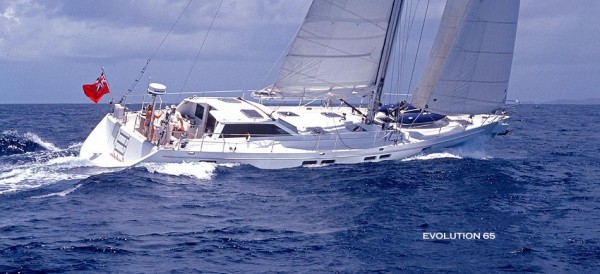
EVOLUTION was one of the early Bermuda Series yachts, built in Holland of aluminum. Her pilothouse contains a watch-stander’s berth, autopilot controls, radar and a complete navigation/ communication complex and the sail controls come to winches and line bins beneath those (what shall we call them?) porches? aft of the pilothouse. There’s a floodlight overhead in each porch to make sense of it all at night. With the autopilot steering most of the time and all of the reefing lines brought to this area through conduits, you could pretty much cross an ocean without ever donning the foul weather gear. You go outside and steer manually when it’s gorgeous, like this. She now sails out of Auckland, New Zealand.
Perfecting the Pilothouse
One aspect of yacht design that particularly interested Paine was the transition area between the deck and interior. With the support of scores of clients, Paine’s office explored just about every possible shelter (hard dodger, pilothouse, porch- call it what you will) twixt cockpit and belowdecks, creating scores of appealing transitions between out- and indoors with minimal impact upon the cabins below whilst maintaining absolute structural integrity.

Larger Yachts
As the office grew in reputation skilled designers were added to keep up with the increasing demand. Large yachts like the 125 ft. KAORI required hundreds of drawings and thousands of hours of engineering. With four highly experienced full-time designers and one office manager, the Paine office undertook yachts of ever larger size and complexity.
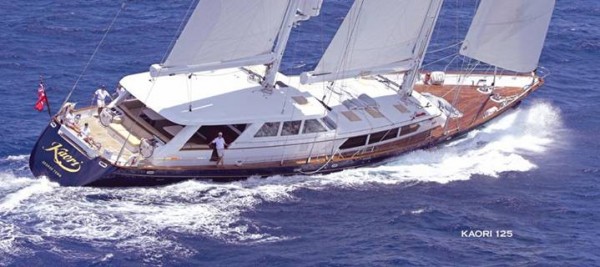
Kaori competing in the St. Barths Bucket Regatta, which she won.
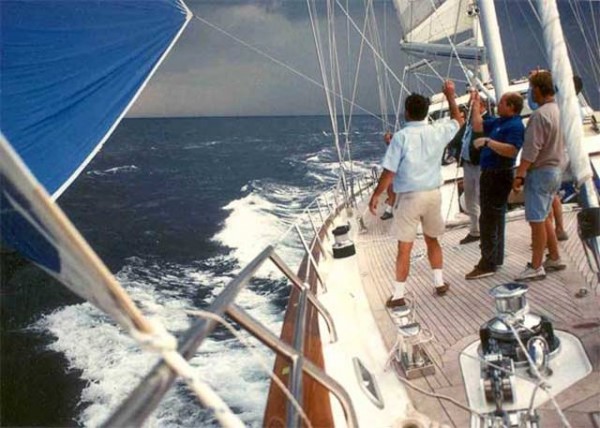
12.5 knots, full spinnaker, squall coming. No worries!

Greener Yachts

Paine designs made extensive use of solar power to help charge the batteries. Leonore has sixteen such panels as you can see.
Global warming, the environmental movement and the ozone hole began to inspire customers. Not only were they attracted to Paine’s office because his refined hulls required less fuel to push through the water under power, but as more and more luxuries became standard fare aboard yachts Paine’s engineers responded to the energy trapped in wind and sun as an appropriate way to power a yacht. Protection from the ever more powerful sun also became an integral part of the package.
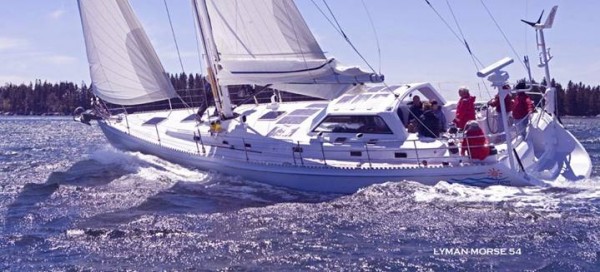
New Morning combines solar panels and a powerful wind generator to eliminate the need for a fossil-powered genset.
Solving the Dinghy Problem
The dinghy is an important and frequently overlooked aspect of life afloat. Paine has done whole designs that revolve around housing the dinghy. One Australian-built aluminum 63 footer had a “beach” in place of an afterdeck, up which the dinghy was power-winched over rollers as you would haul it onto a boat trailer. The 65 footer below demonstrates how the hydraulically powered radarch makes launching and retrieval a pushbutton process.
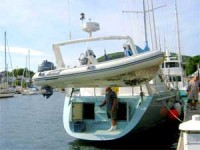
Te Mana with its dinghy ready to launch.
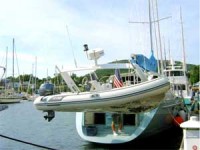
Push the button and in she goes.
Racing Yachts
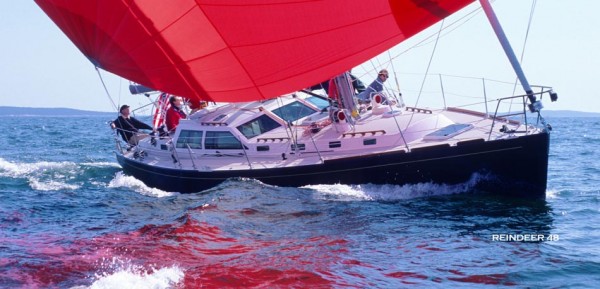
Reindeer V, built in Epoxy by Boston Boatworks and Morris Yachts’ Custom Division.
Increasingly, Chuck Paine’s sailboat lines became known for their seakindly manners and speed. It awaited a bit of the old competitive spirit for his yachts to begin collecting silverware. As cruiser/racers with their draft restrictions, none had the knifeblade keel with a torpedo slung at the bottom that are a necessity in Grande Prix racing. But given offwind courses like the Bermuda Race, Transatlantic, Transpac and most of the other truly fun races, the poor fellow with his ten-foot draft and a handicap rating to match often found himself outclassed by Paine designs that looked like yachts and sailed with crews whose names the owners actually knew. Clients sought out the office for Racer/Cruisers as opposed to Cruiser/Racers.
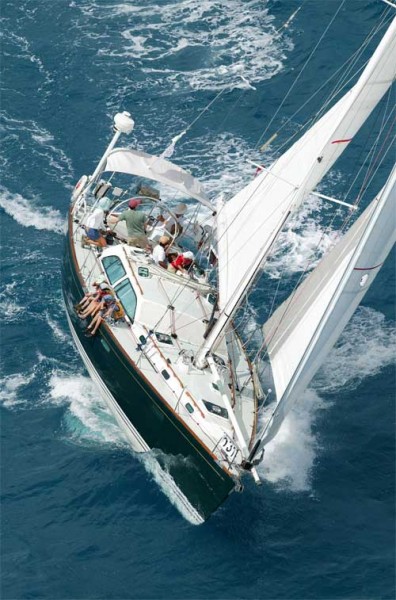
Firefly winning her class at Antigua Race Week, 2007. Five firsts in five races, with only the owner’s small children for rail meat.
The first of these was REINDEER V, followed by FIREFLY, POPPAEA, NEXT BOAT, ERICA and others that will be winning races for generations.
What the Paine office added to the concept of the racing machine was longevity. Add a few pounds of carbon fiber in the right places and racing sailboats can last for decades. Today’s pure racers are throwaway boats, obsolete and abandoned by their owners after a couple of seasons. What a waste! Paine yachts not only began their lives in the winners’ circle, but they kept on winning races, year after year.
The Paine racers were designed simply to go fast through the water, rule be damned, and to last a long, long time. At the point when the expensive throwaway is put out of business by the latest rule change, Paine’s racing yachts acquired an old-age allowance and a new set of sails and were right back at the front of the fleet.
Spirit of Tradition Designs
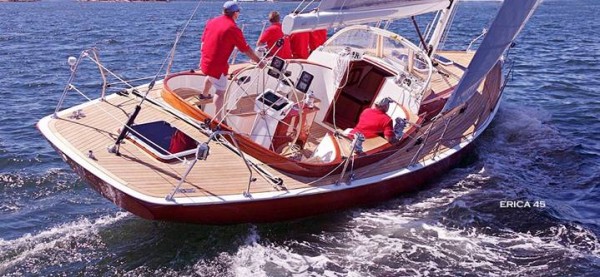
Erica, a 45-foot Spirit of Tradition racing yacht
The “Spirit of Tradition” class of wooden racers has become a forum for design trends worldwide. For owners discouraged by cutthroat racing in yachts that depreciate to nil value in the twinkling of an eye this is the sensible alternative. Even if you’re not doing well in the racing you get to see visions of beauty like this sail by you pointing high, footing fast and looking scrumptious.

Erica’s interior. The seatbacks fold away to reveal wide berths.
Unlike your common stripped-out racing machine, the owner of such a yacht downs his celebratory beers in a sitka-spruce lined interior of light weight and unrestrained elegance thinking, the world is full of fools, and I am clearly not one of them.
Designing for Comfort Afloat
Fine food and wine are part of the modern live-aboard experience. Gone are tiny iceboxes and smelly stoves and toilets that spit back at you. Attention to every detail of the owner’s individual preferences yielded galleys that, while always yacht-like, offered all of the modern conveniences of a fine home.

Leonore’s galley is a wonderful place to practice culinary arts.
Paine’s later owners had that heady combination of money and taste and love of life that counsels you to spend your rare spare time on the water. Sure they could live out their lives up in that corner office worrying about when their investments would rack up the next million (or the next big loss). Many preferred to hire the lads at Paine Yacht Design to exercise their expertise on their behalf, and became the owner of something truly wonderful, like these examples…..
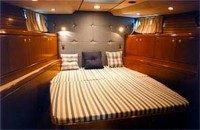
62′ one-off Whimbrel forecabin.
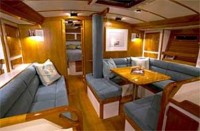
51′ Morris Homefree main salon.
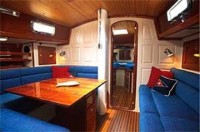
Morris 46 main salon.
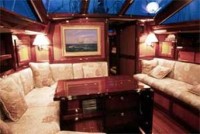
52′ Morris Far Out main salon.
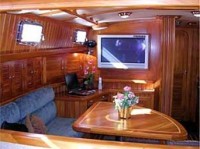
56′ Cabo Rico Madrina main salon.
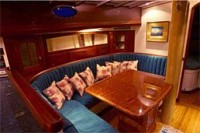
50′ French & Webb Wings of Grace main salon.
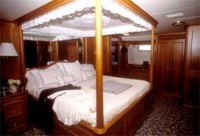
125′ Kaori owners’ suite
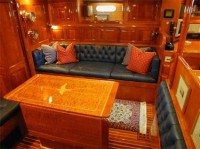
Sumptuous joinerwork on THE 58-foot Pilgrim.
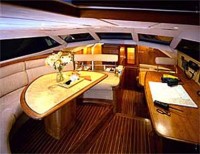
Fruition pilothouse
BOAT OF THE YEAR AWARDS
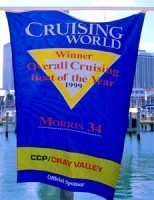
High-Latitude Explorers
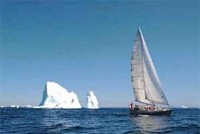
Hamish and Kate Laird’s Seal.
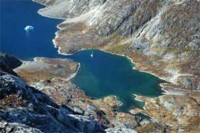
Seal, anchored in some wild and beautiful unnamed cove.
Think you’ve seen it all? At the turn of the 21st century clients began building ice-strengthened aluminum yachts packed with four inches of insulation and triple-glazed windows and high powered heaters and exploring places of unimaginable beauty and remoteness.
Historical Replicas
There were many fine yachts designed in the last century. If their builders had had the materials we have today they would still be around bringing joy to their owners. But we do have those materials today, and Chuck Paine relishes the opportunity to honor the work of design genius gone before by creating yachts whose appeal will endure for generations.

25′ Herreshoff replica Pentimento.

50′ Alden replica Wings of Grace.

44′ Crocker replica Gusto.
Perfected Herreshoff Alerion
A New Beginning
After four years of semi-retirement Chuck has formed a new company, Chuckpaine.com LLC, which will concentrate upon the design and construction of small but exceedingly elegant sailboats. They consist of improved versions of the most timeless of his classic designs in addition to new ones that are introduced at the rate of one or two each year.
THE LEVANT 15 are heirloom-quality daysailing yachts built in modern WEST-system cold molded wood construction by French & Webb in Belfast, Maine. Both are of the perfect size to get going in a matter of minutes without needing to find crew, yet both will make fine yacht club racers for a club that wants to discard their present fleet of ugly fiberglass torture-chambers and add a starting gun for something of real class that can be sailed by older women and men until the sun sets. The boat is easily trailered, launched and hauled, and easily owner-maintained and taken home to the garage for the winter.
FRANCES is a 26-footer that has truly stood the test of time. It is true that the original design is dated, her performance somewhat hampered by an old-fashioned and shoal draft keel. So he has revised the hull lines, making her slightly larger in all dimensions and fitting a fully up-to-date and deeper long-keel. While the flush-decked version will always be the one to turn heads, the new version has a short deck house with full headroom for a six-footer. Study plans are available for US$ 25.00, Full plans without loftings or offsets for US$ 550.00 and full plans including a full-sized mylar hull lofting for US$ 2400.00
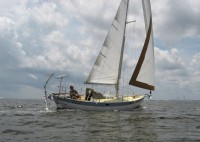
Sign In to Australian Maritime Museums Council
I still can't sign in.
Cookies may not be enabled in your browser. You will need to enable them in order to continue. For more information on enabling cookies, please visit the Ning help centre .
About Australian Maritime Museums Council
…and 479 more
The Australian Maritime Museums Council facilitates communication and the exchange of information between it members
Hello, you need to enable JavaScript to use Australian Maritime Museums Council.
Please check your browser settings or contact your system administrator.
- Hispanoamérica
- Work at ArchDaily
- Terms of Use
- Privacy Policy
- Cookie Policy
Moscow's High Rise Bohemia: The International Business District With No Business

- Written by Dario Goodwin
- Published on March 17, 2015
The Moscow International Business Center (Also known as Moskva-City ) was meant to be Russia ’s ticket into the Western world. First conceived in 1992, the district at the edge of Moscow’s city center is intended to contain up to 300,000 inhabitants, employees and visitors at any given moment and, when completed, will house over 4 million square meters of prime retail, hotel and office space to create what the Russian government desired most from this project: an enormous financial district that could dwarf London’s Canary Wharf and challenge Manhattan . Twenty three years later though, Moscow-based real estate company Blackwood estimates that as much as 45% of this new space is entirely vacant and rents have plummeted far below the average for the rest of Moscow. The only press Moskva-City is attracting is for tenants like the High Level Hostel , a hostel catering to backpackers and other asset-poor tourists on the 43rd floor of the Imperia Tower , with prices starting at $25.50 for a bed in a six-person room. This is not the glittering world of western high finance that was envisioned back in the post-Soviet 90s; but what has it become instead?

As one might expect from a project of this sheer ambition, Moskva-City has a troubled past. The economic crash in 2008 hit Russia hard enough to evict the previous Mayor of Moscow , Yuri Luzhkov, who had been a cheerleader for the district, and replace him with the considerably more austere Sergei Sobyanin, who famously declared that the whole idea was an “urban planning mistake.” But as recently as 2013, the Wall Street Journal was triumphantly claiming that Moskva-City had risen from the dead, citing 80% occupancy rates and glowing quotes from industry insiders claiming that Moskva-City was the "place to be." Driven by record highs in oil prices, Moscow looked poised to become the next Dubai .
Instead, Moscow is now in the grip of an economic winter prompted by western sanctions and drops in the price of oil. The large financial groupings that Moskva-City was meant to shelter have been warned off by their inability to issue credit to international markets, for example - but Moskva-City isn’t just an Empire State Building left empty by the Great Depression.
A fundamental problem that is holding Moskva back compared to the rest of Moscow is the simple fact that currently, getting to Moskva-City is nigh-on impossible at peak hours. Moscow has long been plagued with transport problems, ever since the government failed to match the dramatic expansion of the city with a dramatic expansion of the transport system after the Second World War. Despite being only 2.5 miles from the Kremlin , Moskva-City is only just inside the ring road that bounds the city center and which acts as the only real transport link to it (and as a result, is clogged by construction vehicles.) A railway and metro hub has been finished, but so far only runs a one-stop shuttle service to the closest Metro station that is actually integrated with the rest of Moscow Metro. The isolation of the outer districts is a large, negative part of the Moscow psyche, and it’s not surprising that this is driving away the globetrotting financial elite this project was meant to attract.

The project is managed by architectural practice No.6, which is a constituent part of the large Moscow based practice Mosproject-2 , which is itself a public corporation headed up by Mikhail Vasilyevich Posokhin, who is apparently the “People’s Architect of Russia.” Despite all this state involvement, the project has still managed to become bogged down in bureaucratic infighting - each lot is managed and developed individually, which has led to developers competing for occupants by slashing rates.
Much has been written about the way modern financial districts and towers that inhabit them can be unwelcoming, forbidding or even hostile by design, but the skyscrapers of Moskva-City seem even less friendly than usual. The site - a former stone quarry, chosen out of necessity as the only place in the city center where a new district could be plausibly constructed - is isolated both physically and visually, leaving the cluster a stark anomaly on the city skyline. Even the names seem more imposing than optimistic now: Imperia, City of Capitals , Steel Peak.

The Mercury City Tower , so far the tallest completed building on the site, is officially “a strong reference to Russian constructivism, [which] gives the tower a strong vertical thrust similar to the one found in New York's Chrysler building .” It would be easy to criticize the Mercury City Tower for picking ‘inspirations’ that are so totally opposed to each other - The Chrysler building the defining emblem of American pre-crash confidence and Constructivism created with the express purpose (especially architecturally) of extending the Bolshevik revolution into a social revolution - but the way they smash those two inspirations together is almost beautifully ironic.

Even though the High Level Hostel is less an asset to a financial district than it is a PR problem, it’s been a huge success since opening in September, already ranked 27th out of 766 hostels in Moscow by TripAdvisor. According to the management agency for Moskva-City , 58% of the new occupant signings this year have been non-financial, including a number of small to medium size businesses. Other areas of office space have been occupied by a restaurant and a culinary school, while another space has been redeveloped into a 6,000 seat theater.
While Moskva-City is failing to be a financial district that could take on the world, it’s inadvertently becoming a humanized space catering to the very groups that the Russian economic miracle left behind. Taking advantage of rents lower than the rest of Moscow , the world class facilities and the sheer desperation of the developers, the humanization of Moskva-City could well create the world’s first high-rise bohemia.

Of course, these are not spaces designed for a community, or even for people: these are spaces designed for money, and there’s little scope for changing something that seems so baked into the design of Moskva-City . The High Level Hostel is trading off of the irony of being a hostel in a banking tower, but it’s perfectly possible that at some point people will no longer find this joke funny (especially in a building that seems hostile to the very idea of humor). The isolation of Moskva, even though it allowed this community to spring up in the first place, is just as detrimental to a humanized district as it is to a financial one: even bohemians need to move around the city, or the district risks becoming a black-spot instead of a hot-spot.
Moskva-City’s isolation won’t last forever. The end of construction will open the roads up to traffic, and plans to properly integrate the spur lines of the Metro in this area into the wider system are well under way. The integration of the district will inevitably push up rents, and the Russian economy will eventually boom once again. When that happens, Moskva-City is prime territory to be reconquered by the giants of international finance, and it seems unlikely that the municipal or national governments would want to step in to protect this accidental district. For now, though, the towers capture perfectly this moment of Russia ’s schizophrenic understanding of its place in the world.
- Sustainability
世界上最受欢迎的建筑网站现已推出你的母语版本!
想浏览archdaily中国吗, you've started following your first account, did you know.
You'll now receive updates based on what you follow! Personalize your stream and start following your favorite authors, offices and users.
- Search Search for:
- Architecture
- Military Tech
- DIY Projects

Meet Moscow’s Take On The Twisting Tower: Evolution Tower
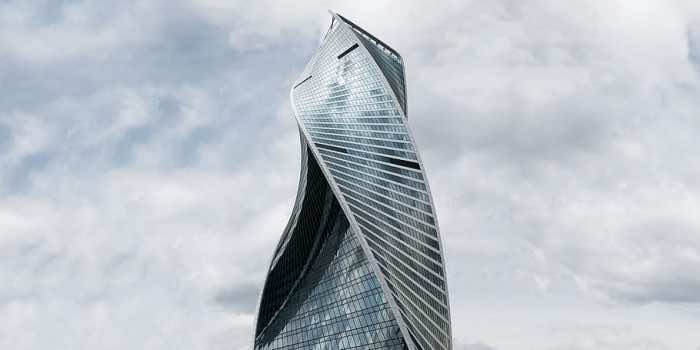
Evolution Tower is a twisting 255 meter tall skyscraper located in ‘Moscow City’, Moscow, an initiative by the Russian government to create a new business district on an old industrial site. The twisting tower provides approximately 85,000 m² of retail and leisure facilities and 85,000 m² of offices and public functions. It is the twelfth tallest building in Russia and the 20 th tallest in Europe.
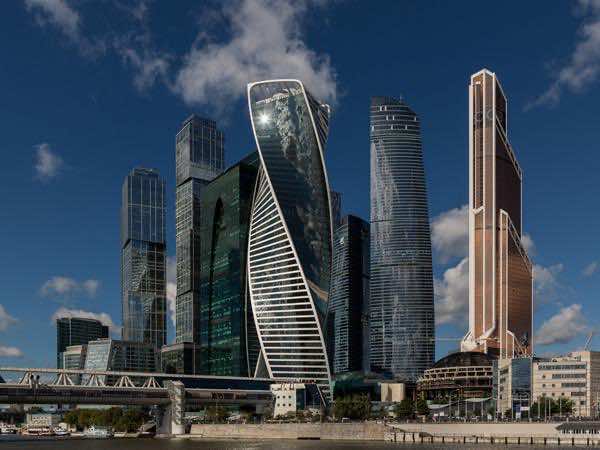
The dramatic form of the tower was designed by architects RMJM in collaboration with Scottish artist Karen Forbes. The double helix DNA inspired form has become an iconic landmark in the Moscow skyline, as the city has never been known for its skyscrapers or architectural identity. The form is also reminiscent of two ribbons wrapping around each other. Each of the 51 floors of the tower is rotated 3 degrees relative to the previous one, so the building is “swirled” by more than 150 degrees. In this way, the central core and eight columns with 15-meter spans between the axes remain strictly vertical all the way up. The spiral geometry is repeated only by four corners of the building. The top of the tower is crowned with two asymmetric “arches” spanning 41 m, visually uniting the two opposite facades.
The facade of the tower boasts a near complete covering of LED lights, this media façade is the largest in all of Asia. The scale and the form of the building made the installation and management of the LED system quite a challenge, thus the building also boasts one of the most sophisticated lighting management and control systems on the planet.
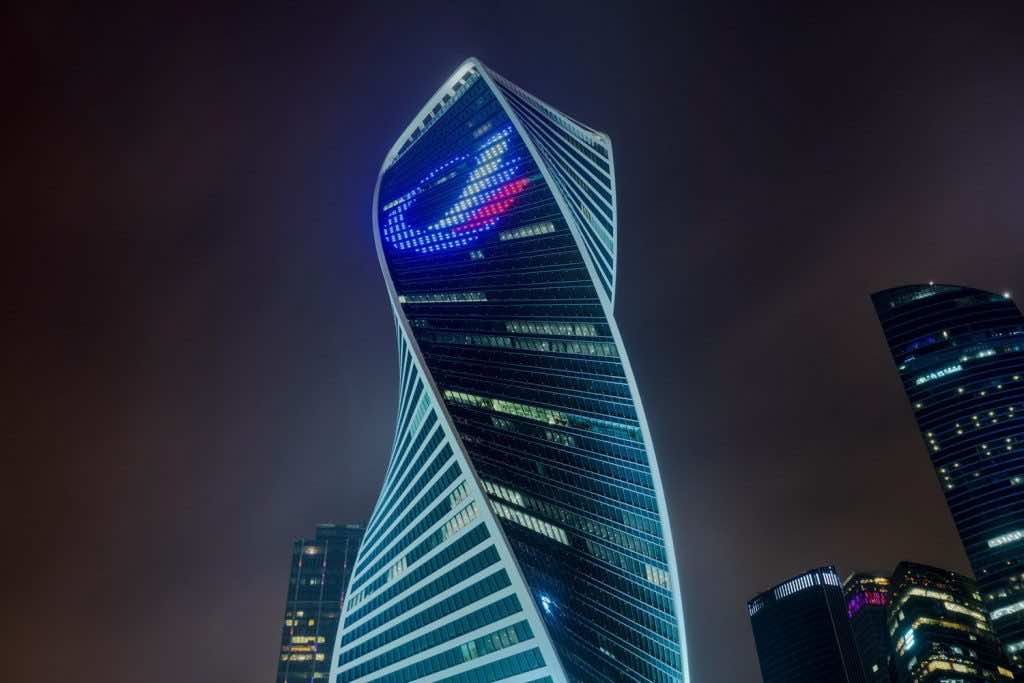
The plot covers an area of 2.55 hectares, of which most are landscaped into a terrace while the rest is used for the tower. The tower and the terrace are built on a three-level stylobate designated the Evolution Gallery with an area of 28,000 square metres (300,000 sq ft). There are exits from the tower that lead directly to the nearby metro station. This podium features a shopping mall and the roof is landscaped to provide additional space for users to unwind in the midst of fountains, terraces and cafes, thus providing a strong connection with the larger urban sphere.
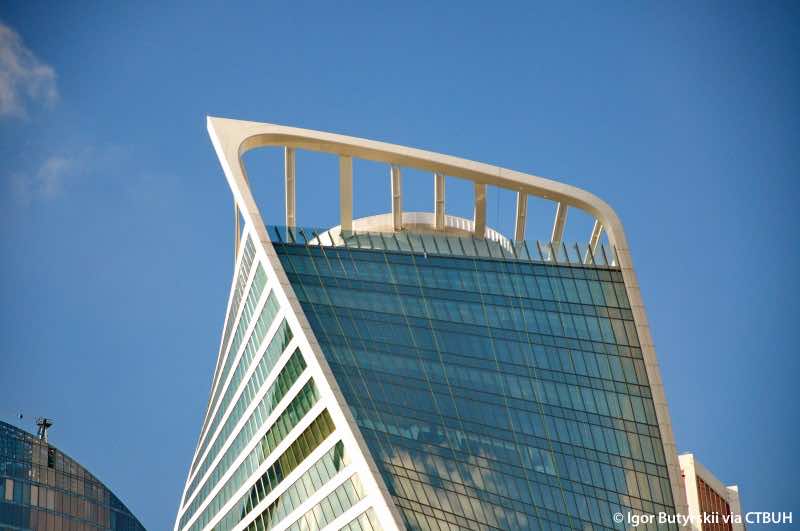
Leave a Reply Cancel reply
Your email address will not be published. Required fields are marked *
Notify me of follow-up comments by email.
Notify me of new posts by email.


- Remember me Not recommended on shared computers
Forgot your password?
- Payware Airports and Scenery Reviews
Scenery Review : Moscow City XP by Drzewiecki Design
- drzewiecki design

By Stephen September 24, 2016 in Payware Airports and Scenery Reviews
- Reply to this topic
Recommended Posts

You fly for hours, anticipating your arrival, wanting to take in the area and the views of another country far away from your departure airport. The airport and the area you leave from is detailed and visually full, and you know you have a great airport scenery waiting for you at the other end of the flight, then when you arrive...
... Nothing, but flat plain emptiness and the same boring standard X-Plane basic scenery, worse there is no OSM (Open Street Map) data in the tile either, so there is no road or autogen detailing in there as well, just well nothing.
When Drzewiecki Design released their UUEE Sheremetyevo Airport XP , I loved it because it was like a visitor from the Cold War past, the Soviet era, and it was also great scenery and great choice of a destination to fly to from any of the capitals of Europe... but that was it, just this great airport in the middle of nothingness, bland.... zero ville.

Now Drzewiecki Design has released "Moscow City" a scenery package to compliment their UUEE Sheremetyevo, and boy how much a difference this release has done to this totally boring area.
To get the full first impression effect I flew JARDesign's A320neo from EFHK Vatnaa, Helsinki to UUEE Sheremetyevo which is flight Finnair AY153 which is a daily 9.25am service.

First Impressions
I was surprised to start picking up scenery still quite away out from central Moscow, as I approached my 6000ft transition altitude. Here there was buildings and houses and the physical visual notes you were arriving somewhere.
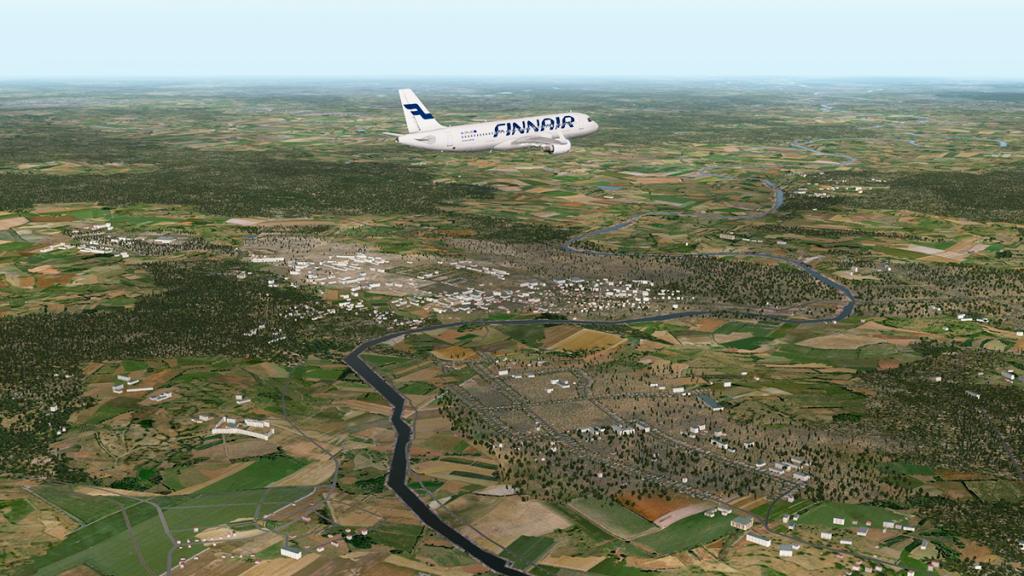
Looking hard at the horizon through the A320's windows and you could see the iconic silhouette of Moscow city.
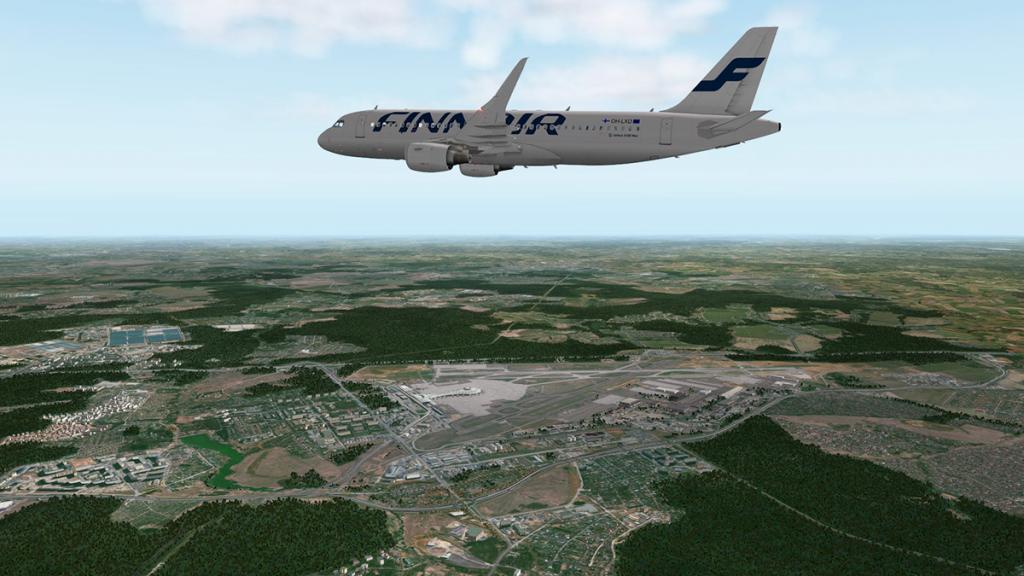
The scenery provides lite versions of all Moscow's Airports, this is UUWW Vnukovo, which was easily recognisable as you flew over. As you fly closer to the centre of the city the density of the objects below becomes quite heavy as the landscape fills in. You have all kinds of infrastructure including, blocks of flats, tower blocks, factories, housing, skyscrapers and almost everything that makes up an urban landscape, in all there is 2000 custom-made buildings that makes up this impressive scenery.
A note here in that you don't get that rolling as you move feeling effect where as it just suddenly appears in front of you and then quickly disappears behind as soon as you have flown out over the area. There is a slight effect of that as there has to be, but only in the far distance and as you can see from the images the views in every direction are widespread and visually it is very good to excellent.
The "Seven Sisters" or "Stalinist skyscrapers" built from 1947 to 1953 are all in the scenery with their "Wedding Cake" architecture or officially Russian Baroque - Gothic style. Most famous is the Moscow State University, front and centre of the image below.

Central Moscow is excellent and extremely realistic, and you really need a travel guide to pick out the landmarks and detail, but it is hard to miss the Red Kremlin complex and St Peter's square from the air. Both sides of the aircraft is visually full until you have crossed right over the city.
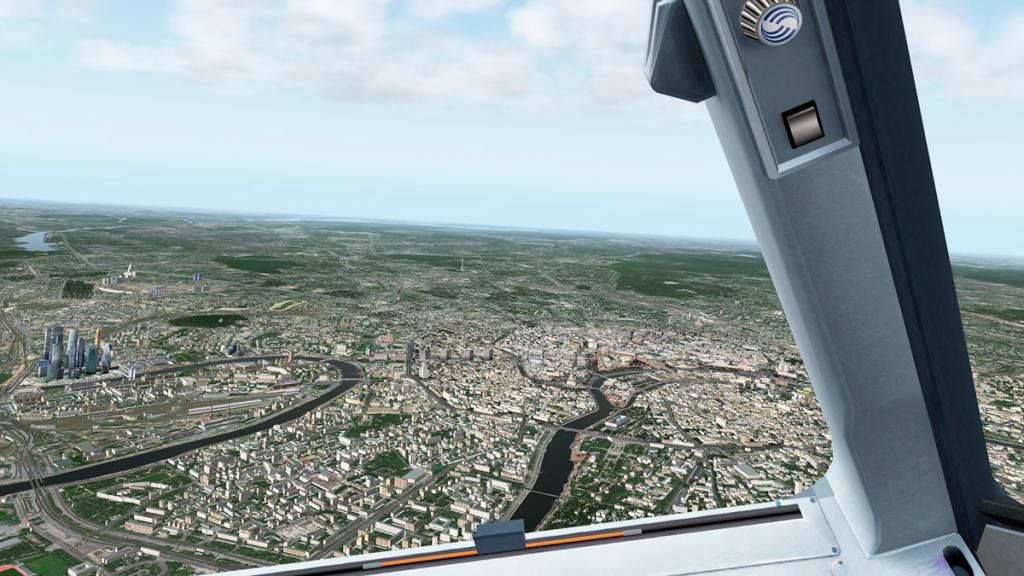
I am not a fan of the generated 3d OSM scenery, but this is very good in blending in perfectly with the X-Plane default scenery and giving you a smooth transition from country to urban and back again with great realism.
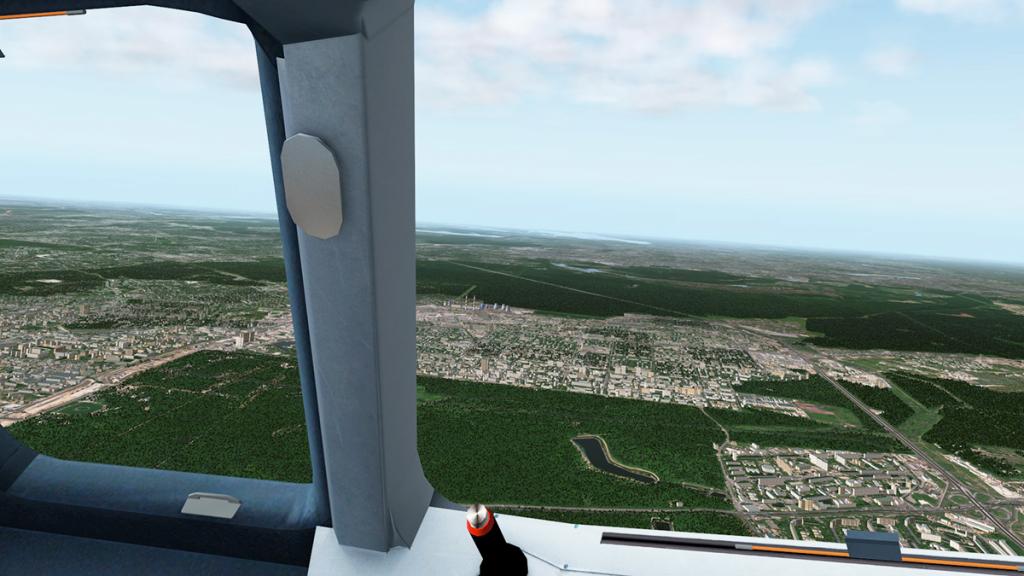
Over the city and turning north towards Sheremetyevo, another Moscow airport UUMU Chkalovsky is represented on the turn.
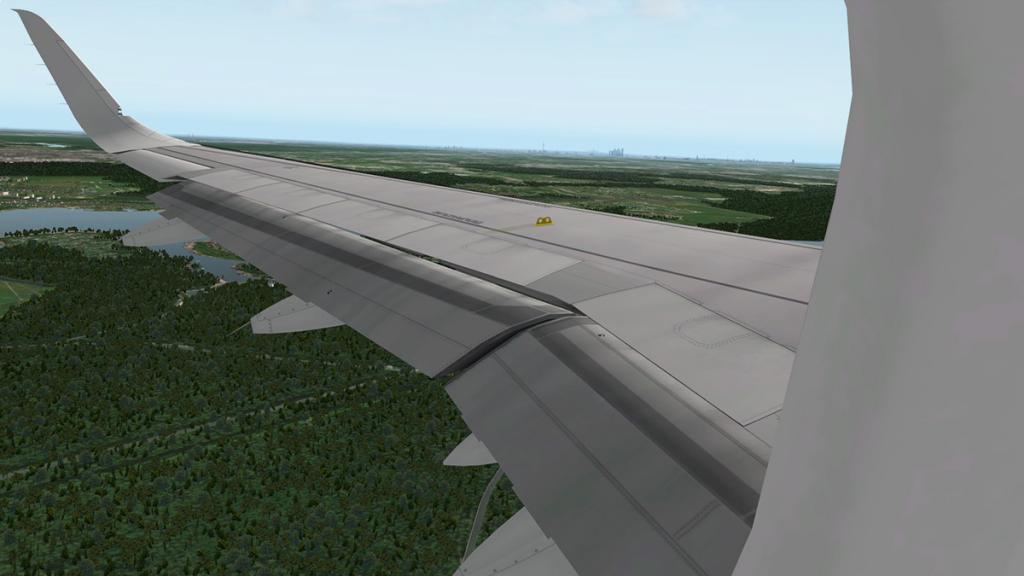
The city skyline is now easily visible on landing at Sheremetyevo, and that really helps in the arrival factor, more so in that the cities building infrastructure spread now comes up and around the airport to fill the gaps to the city itself, and making the original Sheremetyevo scenery that was so open and lonely in the old X-Plane view is now a big part of the whole in this combination. No doubt it really brings this always good scenery now alive and very usable.
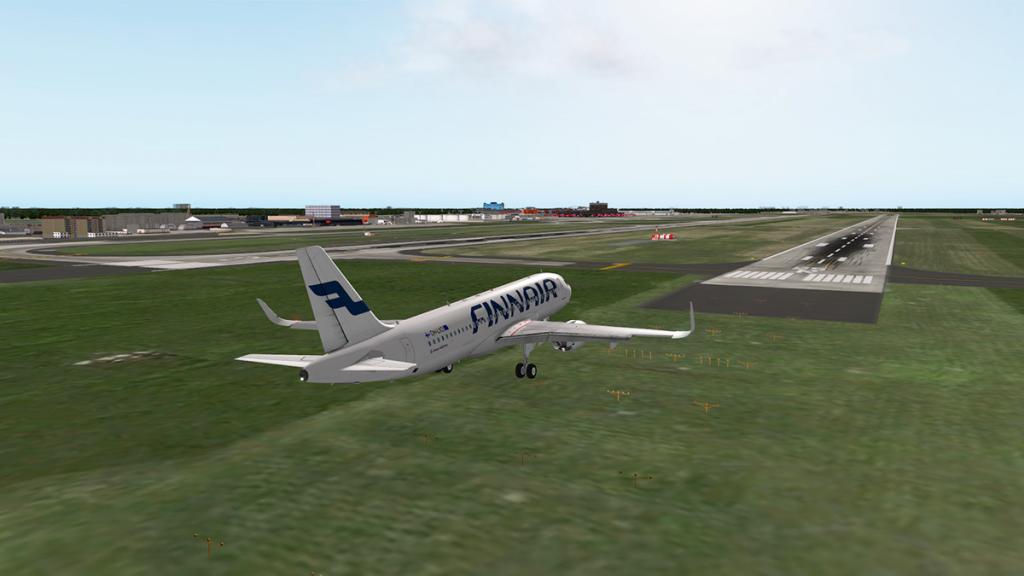
Sheremetyevo Airport
Before we move on to the city itself. It is important to note the area around UUEE Sheremetyevo itself.
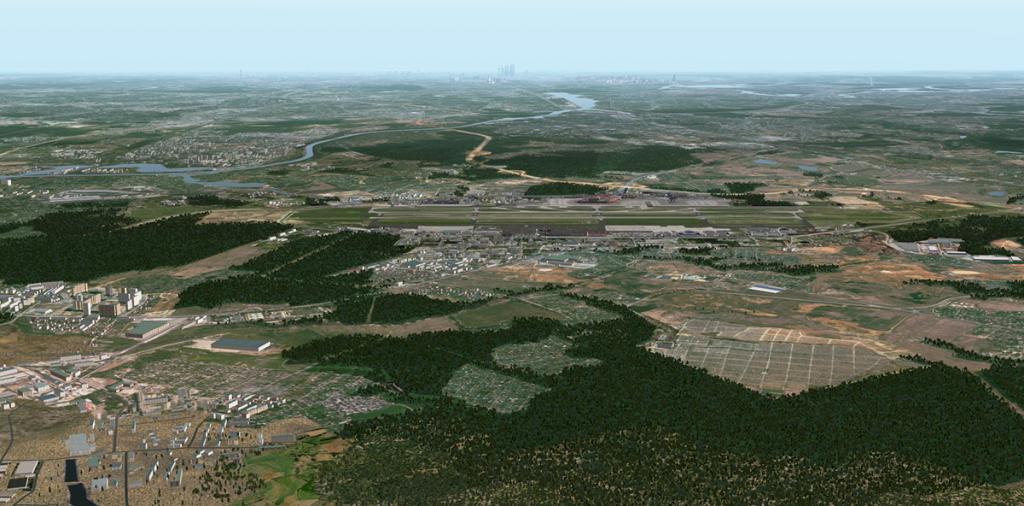
Compare the large image above to the earlier image at the start of this review to see the amount of change there is around UUEE Sheremetyevo with the addition of this Moscow City package. The two sceneries are of course meant to be used together, and in reality it would look odd if you had Moscow City scenery installed without the Sheremetyevo scenery included to fill out the northern areas. A highlight is that both sceneries together form a single whole, as the areas between the airport and the central city area are well filled in and that gives you a huge area of coverage and the full visual aspect.
To get a closer lower look at the Moscow Center I commandeered Dreamfoil's lovely Bell 407.
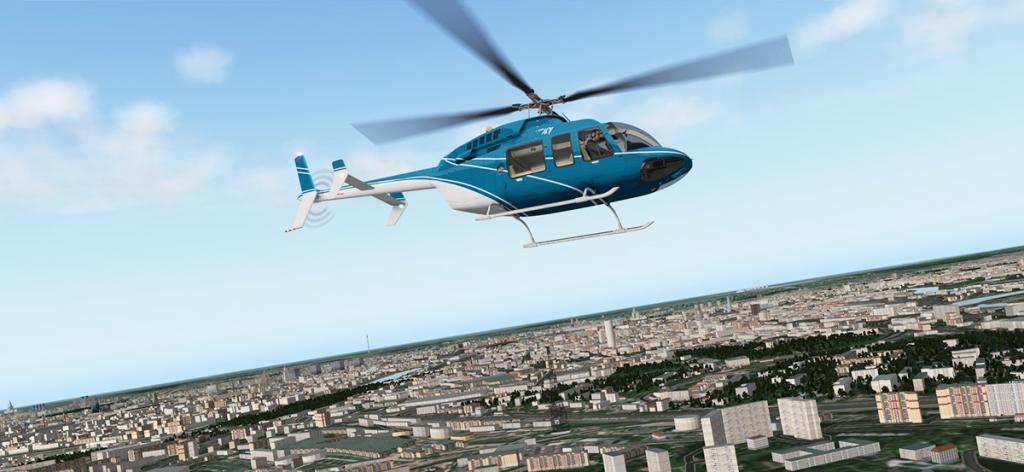
There is a 4.000km² total area covered with this scenery here, and you have expect some sort of building replication to cover all that ground. There is of course but as well in the fact there is also enough variations as to not keep it all interesting and not obviously visually obvious.
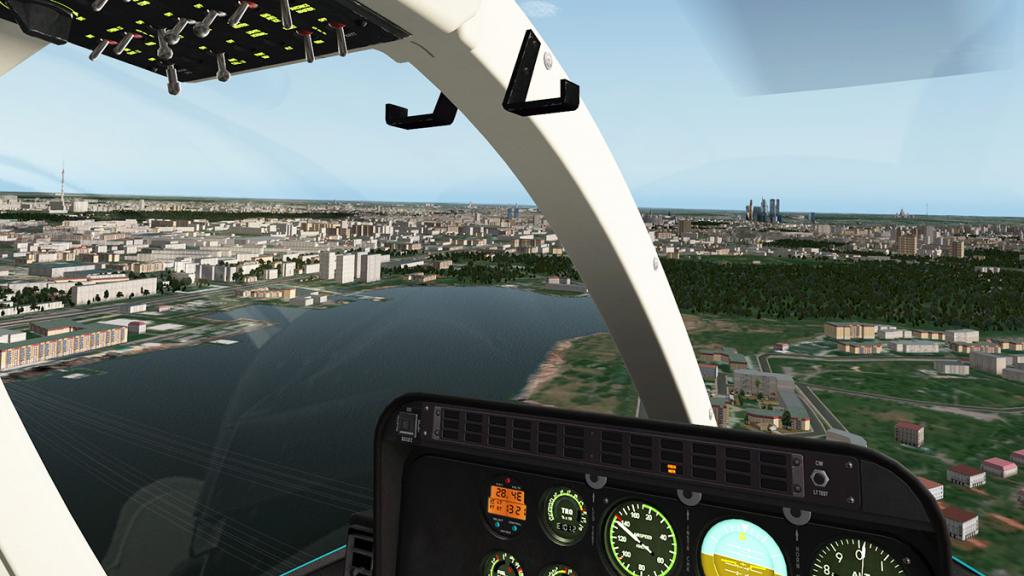
The closer you go to the central area, the variations in the buildings change there in style and density as well. And then more of the iconic buildings start to appear as you get closer in again to the middle. The business district is excellent, with a lot of business towers and the more modern futuristic skyscraper architecture that stands out in every view point in eye scans across the city.
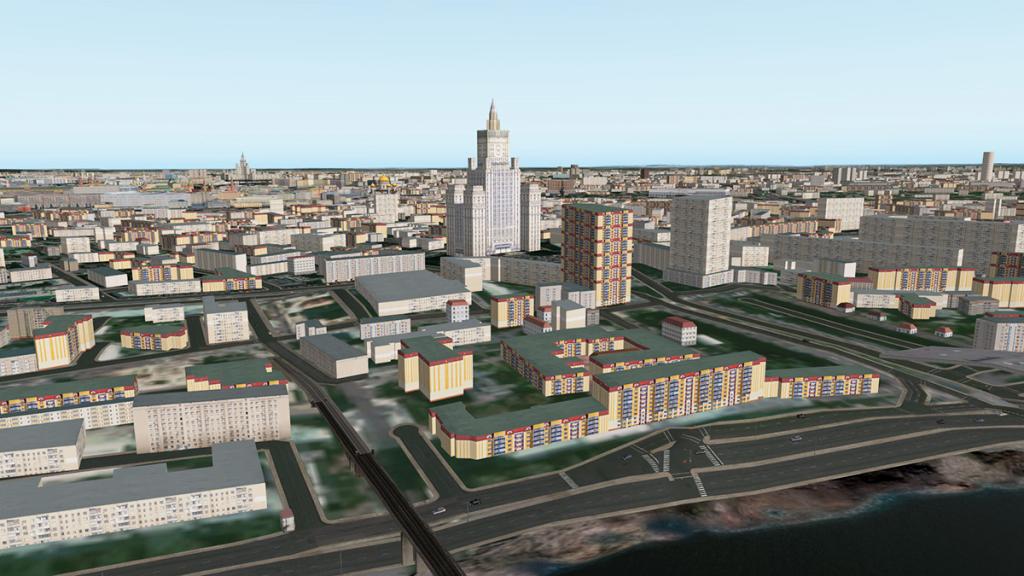
The more recent is in tune with the more older Stalinist era that makes up the Moscow skyline.
The Kremlin Complex and the Cathedral of Vasily the Blessed (St Basil's) is excellently represented and so is "Red Square"
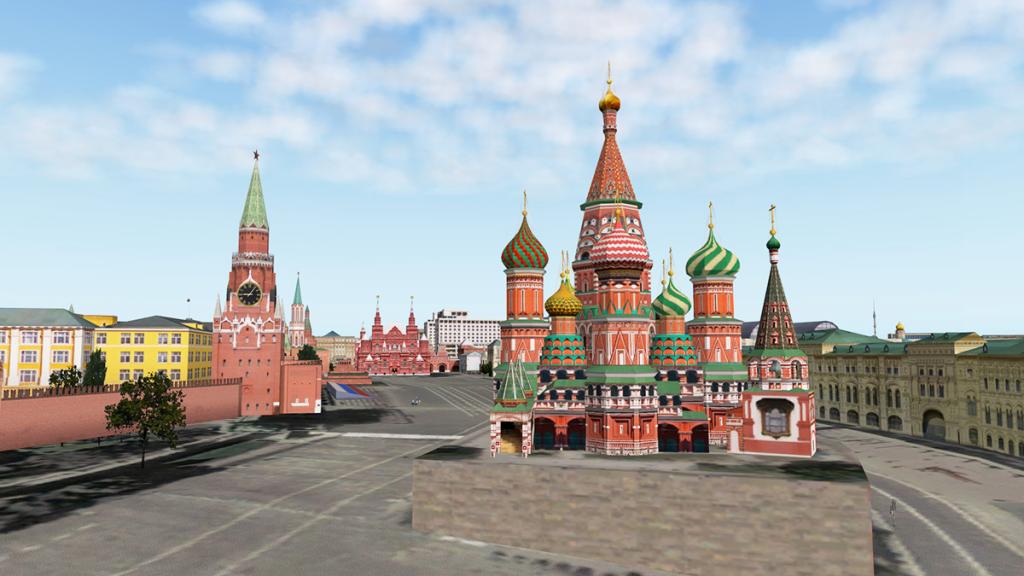
There are Orthodox churches everywhere and all the big icons in the Moscow Cathedral Mosque, Cathedral of Christ the Savior, Grand Arena of the Central Lenin Stadium, Otkrytive Arena and department stores, museums and power stations and more....
I did have issues with many buildings floating, including the Kremlin. I tried both "Runways follow terrain contours" on and off with no flattening of the objects and there is no information in the manual either on how to fix the problem.
Night lighting is very good, yes there is again a repeatable pattern to the majority of the hundreds of the apartment blocks that does stand out, but the more individual buildings do all have that personal touch and some buildings look really very good.
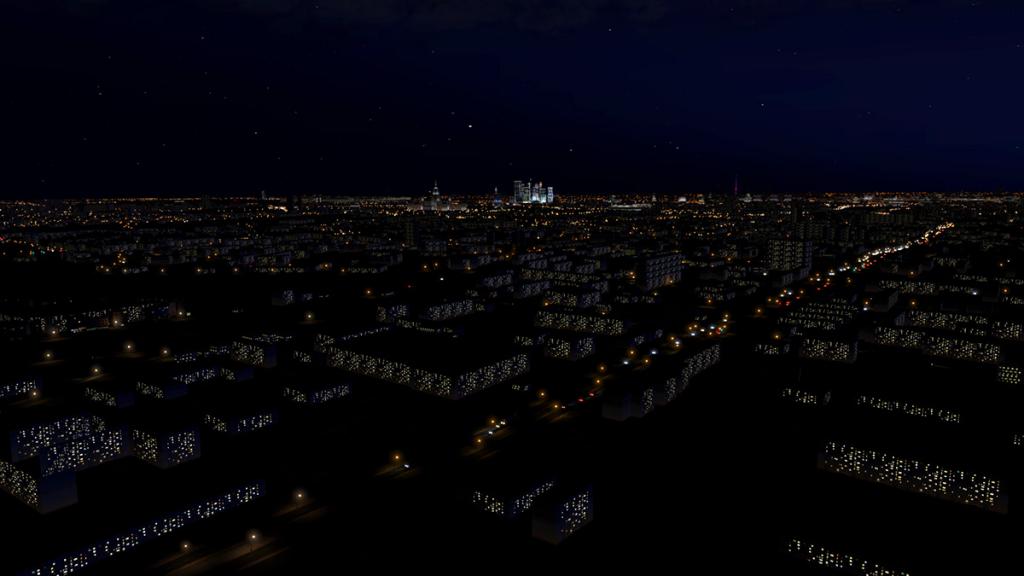
The highlight here is the business district which looks magnificent and is very realistic from any direction at night as is the lit Stadium.
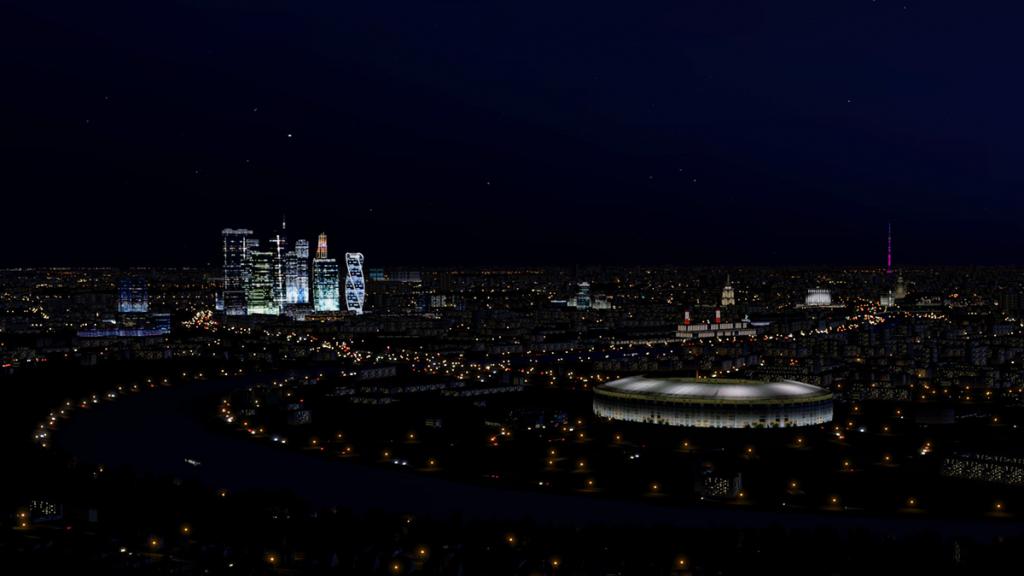
Although away from the central area the Ostankino Tower that stands 540.1 metres (1,772 ft) tall, and is the tallest freestanding structure in Europe and it looks great at night and is a very good position indicator from the air from any direction.
Included Moscow Airports
As noted also included in the scenery are seven airports and several helipads.
UUWW Vnukovo
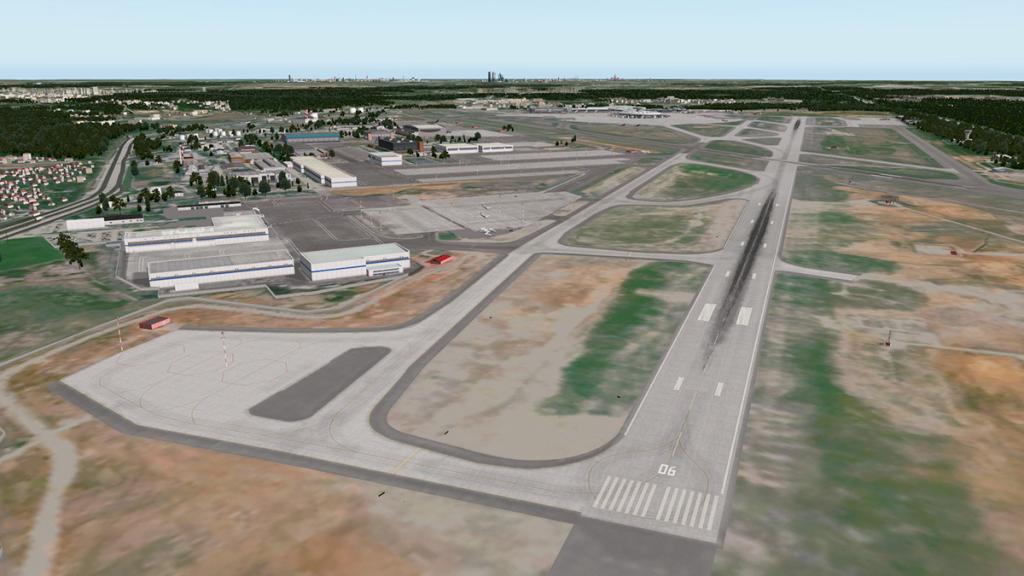
The futuristic Vnukovo International is very good for a lite version, with great terminals and lots of small detailing. Only thing missing is the static aircraft and a bit more ramp equipment, but otherwise it is highly usable.
UUDD Domodedovo

The oldest of Moscow's International airports is Domodedovo. Again it is quite devoid of static aircraft and I am not crazy about the blue terminal glass work, but it is still a very workable scenery to use and has a lot of well made objects.
UUBW Zhukovsky

Zhukovsky was a major aircraft testing facility since the cold war years, with most of the major Russian Experimental Design Bureau's having facilities here. It is also now used by the Ministry of Emergency Situations! and cargo carriers. It was also used as a test site for the Soviet Buran reusable Spacecraft because it has the world's second longest pubic runway at at 5,402 m (17,723 ft). Mostly it is a collection of very large hangars but has a lot of static aircraft in storage.
UUMO Ostafyevo International Business Airport
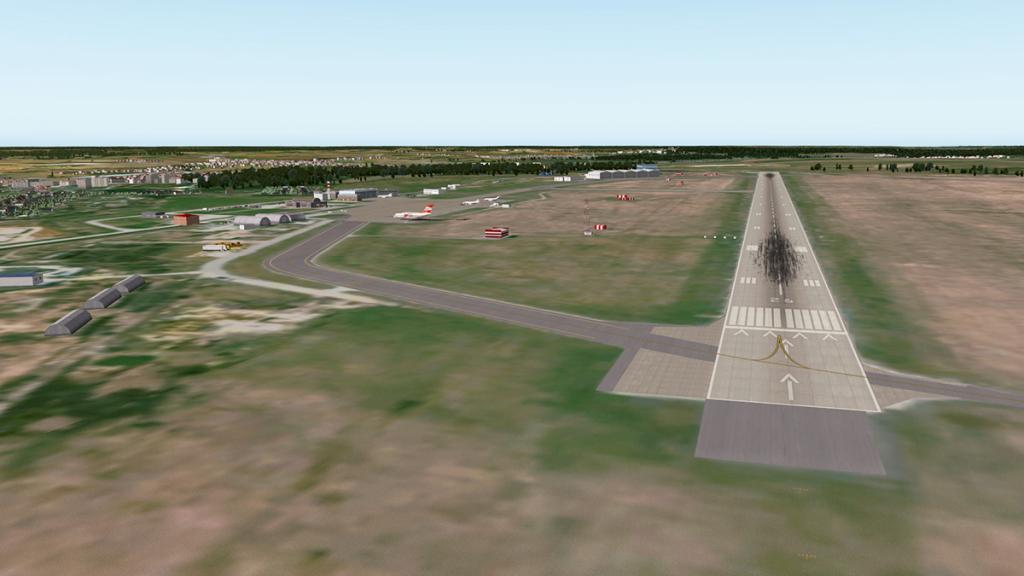
A former military airbase. Ostafyevo features a new modern glass terminal, and caters primarily to business aviation.
UUMU Chkalovsky

Chkalovsky is a military logistics airport that is famous for it's support for the Russian Space program and transport to Star City and the Yuri A. Gagarin State Scientific Research-and-Testing Cosmonaut Training Center. Yuri Gagarin left here on his final flight before crashing by the town of Kirzhach.
UUBM Myachkovo Airport
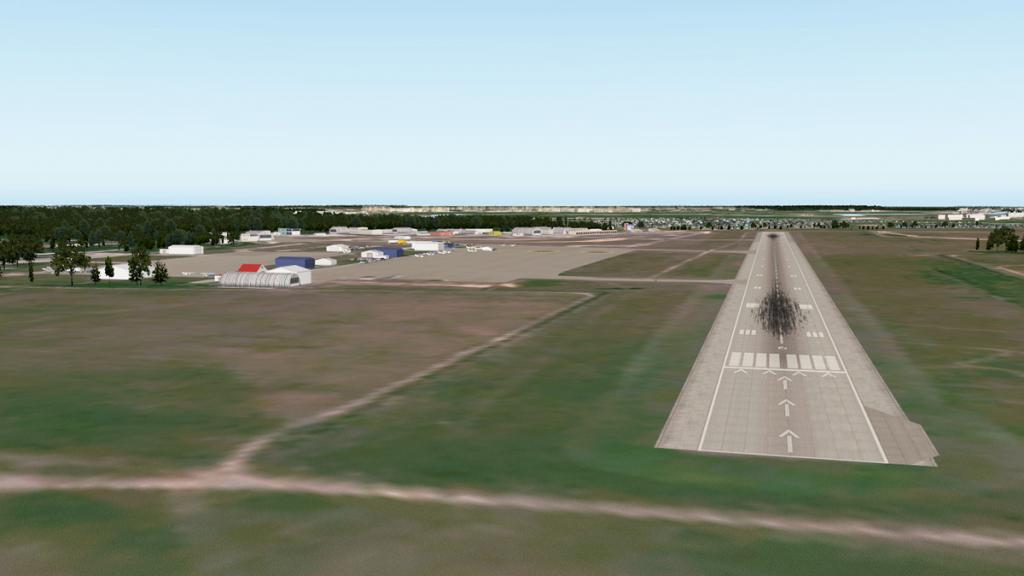
Myachkovo is a small General Aviation Airport that is owned by the Finpromko company. Cargo aircraft up to the size of the Ilyushin ll-76 freighter can also use the airport.
UUMB Kubinka

Kubinka has been a significant Russian military airbase and large airshows are held here to show off the Russian military might.
There is also provided UUU1 Kremlin Airport, within the Kremlin walls, but I couldn't get it to work? There are two pads in H1 and H2.
Your first thoughts after reviewing this excellent Moscow scenery is not with this actual package. You then wish that you could have this extensive scenery at London, Rome, Madrid, Berlin and the list could go on with any of your favorite European Cities, and don't count a load in the Middle East and Asia. But a London scenery like this would certainly be a godsend in our X-Plane world. Drzewiecki Design has already done Warsaw and Manhattan, so there is always hope.
It is not cheap either and you need to add in their UUEE Sheremetyevo scenery package on top of that as well. But you get an awful lot of ground covered here for your money, with the area covered here that is extensive... huge and flying into Moscow will never be the same again.
A few areas to note in one that in my case a few of the buildings floated, the download is huge load at 1.4gb and this Russian area is not the best for navigation aids and programming FMS units as most waypoints are not recognised. Most of the airports ILS coordinates also have to checked and recalibrated (Drzewiecki Design do provide all the correct coordinates) so there is a little work to do to set up repeat services but the work is worth the results.
Not only is the actual Moscow city and all it's buildings supported, you also get seven (if lite versions) of Moscow's other airports included as well, but the framerate processing of all this huge amount of objects and scale is pretty good to excellent. Framerate does hurt more on a lower (helicopter) level and certainly you need a computer with a little extra power is in no doubt required, but overall for the size of the area the scenery is extremely efficient.
Yes I was impressed by this Moscow City Scenery, as this once very barren area of X-Plane is now a very attractive repeat destination as nothing can give you a greater fulfilment than seeing your destination appear in the distance and then give you a huge visual experience as you fly over and approach your destination.
Moscow City certainly delivers that and more... Just more sceneries like this please!

Moscow City XP by Drzewiecki Design is NOW available! from the X-Plane.Org Store here :
- Extremely detailed model of Moscow metropolitan area in Russia
- Almost 2000 custom-made buildings and other objects, all high quality, FPS-friendly and with night textures
- Whole Moscow center done in 3D as well as all other important landmarks - museums, palaces, skyscrapers, towers, bridges, railway stations, Zara stores...
- Trains, ships, 3D people, cars, airport vehicles, static aircraft - anything you can imagine
- About 4000 sq.km of photoreal 0,5-1m/pix terrain with autogen
- Sceneries of all surrounding airports including UUWW Vnukovo, UUDD Domodedovo, UUBW Zhukovski, UUMO Ostafyevo, UUBM Myachkovo and UUMB Kubinka, with all airport buildings, detailed layouts, people, airport vehicles and more
- Very detailed Kremlin model with newly constructed heliport
Requirements
_____________________________________________________________________________________
Installation and documents:
Download for the Moscow City XP is 1.47gb and the unzipped file is deposited in the "Custom Scenery" as four files:
DDZ Moscow City XP (3.99gb) - Yes GIGABYTES!
DDZ Moscow City XP Layer 2 (30.20mb)
DDZ Moscow City XP Documents (1.0 mb)
ZZZ_DDZ Moscow City XP Terrain (20.10mb)
Installation for Windows comes with an .exe installer that deposits the files in the correct order required (however I still moved the ZZZ- folder to the bottom via the INI text install list.
Installation Instructions are provided for Mac and Linux
You need to check all airports ILS coordinates are correct, instructions are provided.
Documents: Two documents include
Moscow City XP MacLinuxinstall
Moscow City XP Manual (seven pages)
Review System Specifications:
Computer System : Windows - Intel Core i7 6700K CPU 4.00GHz / 64bit - 16 Gb single 1067 Mhz DDR4 2133 - GeForce GTX 980/SSE2 - Samsung Evo 512gb SSD
Software : - Windows 10 - X-Plane 10 Global ver 10.50
Addons : Saitek x52 Pro system Joystick and Throttle : Sound - Bose Soundlink Mini
Plugins: JARDesign Ground Handling Deluxe US$14.95 : WorldTraffic US$29.95
Scenery or Aircraft
- Airbus A320neo by JARDesign ( X-Plane.OrgStore ) - US$59.95 : A320neo Sound Packs by Blue Sky Star Simulations ( X-Plane.OrgStore ) - US$19.95
- Bell 407 by Dreamfoil Creations ( X-Plane.OrgStore ) - US$34.95

Link to comment
Share on other sites.
- 7 months later...

Thank you for this very thorough (as always) review. I just bought it (it's on sale) and have only one disappointment so far: Red Square has no ILS or any landing aids at all for that matter. And what a nightmare of an approach! Also I was hoping the package would include an add-on that gives my c172 a big cup holder for my Stoli. Otherwise the scenery is gorgeous. What a country!
Join the conversation
You can post now and register later. If you have an account, sign in now to post with your account. Note: Your post will require moderator approval before it will be visible.

× Pasted as rich text. Paste as plain text instead
Only 75 emoji are allowed.
× Your link has been automatically embedded. Display as a link instead
× Your previous content has been restored. Clear editor
× You cannot paste images directly. Upload or insert images from URL.
- Insert image from URL
- Submit Reply
Recently Browsing 0 members
- No registered users viewing this page.
- Existing user? Sign In
- General Aviation
- Helicopters
- Classic Aircraft
- Plugins/Apps and Simulator Addons
- Behind The Screen
- Forums Index
- Create New...
- BoteCote Epoxy
- LuciClear Resins
- Epox-E-Glue
- Epoxy-Other
- Marine Paints
- Rot and Rust
- Rollers, Trays etc.
- Safety Gear
- Fibreglass Cloth
- Vacuum Bag Stuff
- Marine Carpet
- Marine Plywood
- Hobby Materials
- Hoop Pine Timber
- Strip Planking
- Davey Bronze
- Wood Screws SiBronze
- Bolts Silicon Bronze
- Nuts, Washers, Pins
- Rod & Bar Silicon Bronze
- Nails Silicon Bronze
- Copper Nails & Roves
- Monel Staples
- Books, Magazines, CDs
- Plans & Kits
- TestCategory
Valid XHTML 1.0 Transitional

IMAGES
COMMENTS
David Payne is a well-known Australian boat designer who has a myriad of traditional or contemporary boat designs and stock plans. Designs are for a range of boats including plywood, clinker or lapstrake, and strip plank boats. ... He has done an amazing job of interpreting David's Drawings and enhancing the design by increasing the top sides ...
David Payne Yacht Design has a wide range of traditional or contemporary boat designs and stock plans, for the amateur or the professional builder. If you want to build your own boat there are designs for a range of wooden boats including plywood boats, clinker or lapstrake boats and strip plank boats, as well as designs for steel yachts. ...
David Payne's uncle, Alan Payne, designed some of the most successful yachts the world has seen, as well as many very successful commercial boats. David is a very successful and capable boat designer too, and, importantly draws on his family heritage and the richer heritage of Australian boatbuilding history through his work with the Australian ...
Here in Australia, another boat was built about the same time, to my original rig plan, with a different cabin, also on the plans, and that has been quite successful too. Its a nice style of boat to design, and one of my first as an independant designer. David Payne. [This message has been edited by David Payne (edited 10-12-2001).]
The Snapper Boat was drawn up for us by David Payne along the lines of the Snapper fishing boats of either side of the turn of the 20th Century. We were looking for a local working boat type that would be suitable as a half-decked family trailer-sailer with the option of an inboard engine and the Snapper Boat fits the bill admirably.
The distinctive design of the Queensland Moreton Bay cruisers and the Halvorsen cruisers from NSW has been incorporated into this motor launch commissioned from our Sydney based naval architect David Payne. With many appropriate semi-protected waterways around Australia, this is an ideal boat for the leisurely weekend and holiday cruising.
The Pittwater Scull is a performance orientated, single chine, V-bottomed plywood hull, only 4.65m long and 770mm wide. Using 3mm thick... $165.00. Add: 0. Woodie. A 3.36metre plywood planing dinghy. As the revival in wooden boat building continues to gather strength, this design sets out to grab a share of the metal boat market, challenging the...
08-11-2013, 01:23 PM. Re: David Payne Snapper Boat To answer your question about tacking in light winds, the basics are that a deep keel (or portion of a keel like the Snapper's deep skeg) running fore and aft will make a low speed displacement boat track straight, and handle better under power. In small boats a good example is the Whitehall ...
The Snapper Boat 17″ (5.2m) Plans | January 25, 2019. The Snapper Boat was drawn up for us by David Payne along the lines of the Snapper fishing boats of either side of the turn of the 20th Century. We were looking for a local working boat type that would be suitable as a half-decked family trailer-sailer with the option of an inboard engine ...
Now it has come home again to Sydney, within sight of where it was built. SY Ena is now part of the National Maritime Collection at the museum. The extremely generous donation of the steam yacht by its owner Mr John Mullen. The launch of SY Ena as noted in the Sydney Morning Herald, 10 December 1910. Image: National Library of Australia via Trove.
Posted on 26 Sep 2013 by David Payne. The action for final race for the America's Cup in 1983, dubbed 'the race of the century' by US skipper Dennis Conner, began well before the race started. Mindful of some starting issues, the Australians called for a lay day after race six to put some practice in. Meanwhile, the US team used this to ...
I have been using Cop-R-Bote on my catamarans since 1988.... Featured [more] Epox-E-Glue 200gram Kit White and Coloured
C. W. Paine Yacht Design, Inc. operated from then until 2008, launching well over 1000 yachts with a combined value exceeding US$ 350,000,000. From the beginning his firm specialized in the high quality, high-priced end of the trade, designing both sail and powerboats, though it is probably best known for its offshore oriented cruising yachts.
Alan Payne (right) and Bryce Mortlock (next left) constructing a Payne-Mortlock sailing canoe, late 1940s.. Alan Newbury Payne AM (11 December 1921, London - 20 June 1995, Sydney) was a naval architect born in England but who worked in Australia.His yacht designs were readily built by both professionals and amateurs, and remain well represented in the ocean-going and coastal yacht fleet.
Alan Payne continued with cruising yacht design, mainly deep keeled steel yachts. His nephew Geoff Payne built one of these, the SKOOKUM, which earned a reputation through Cruising World magazine as a tough and adventurous boat. ... Personal recollections and notes from David Payne, nephew and employee of the Australian National Maritime Museum ...
Name David Payne Organisation Australian National Maritime Museum Position/Role Curator, Australian Register of Historic Vessels Email Address [email protected]
Drzewiecki Design is pleased to inform you that they have released Moscow City X. Moscow City is without doubt a very detailed model of Moscow metropolitan area in Russia, together with lite sceneries of 7 airports, many heliports and thousands of buildings. It took almost a year to complete and it includes countless fantastic features. The FPS/VAS-friendly design and advanced optimization ...
The Moscow International Business Center (Also known as Moskva-City) was meant to be Russia 's ticket into the Western world. First conceived in 1992, the district at the edge of Moscow's city ...
Sharjeel T. April 1, 2021 0. Evolution Tower is a twisting 255 meter tall skyscraper located in 'Moscow City', Moscow, an initiative by the Russian government to create a new business district on an old industrial site. The twisting tower provides approximately 85,000 m² of retail and leisure facilities and 85,000 m² of offices and public ...
David Payne Boat & Yacht Plans for sale. Fast Delivery.
Now Drzewiecki Design has released "Moscow City" a scenery package to compliment their UUEE Sheremetyevo, and boy how much a difference this release has done to this totally boring area. To get the full first impression effect I flew JARDesign's A320neo from EFHK Vatnaa, Helsinki to UUEE Sheremetyevo which is flight Finnair AY153 which is a ...
Epox-E-Glue 200gram Kit White and Coloured. $39.05. Feronite Rusty Metal Primer 250ml
Epox-E-Glue 200gram Kit White and Coloured. $39.05